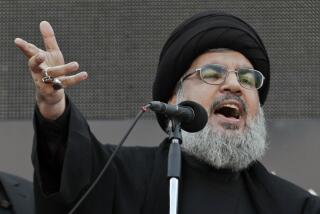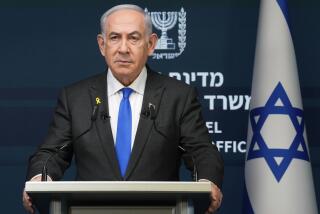Slaying Is Seen as Israeli Vengeance
JERUSALEM — More than two months ago, Israelis collectively shuddered when they heard the news that Palestinian militants in the Gaza Strip had paraded the body parts of Israeli soldiers killed when they and their armored personnel carrier were blown to pieces by a roadside bomb.
Now Israel appears to have settled the score.
Headlines in Israel’s national newspapers Friday noted with grim satisfaction that one of three Palestinian militants killed in an Israeli airstrike Thursday night was a man who had been seen triumphantly displaying what appeared to be the head of a slain Israeli soldier.
“Death of the body snatcher,” read the headline in the Yediot Aharonot daily.
The Israeli military said Friday that the man, Hakim Rahim, a local commander of Islamic Jihad in Gaza, was targeted because he had been planning other attacks against Israelis. An Israeli army news release about Rahim’s death in the missile strike in Gaza City, which killed two other Islamic Jihad members, referred only in the most circumspect fashion to his involvement in “incidents” surrounding the May 11 attack on the Israeli armored personnel carrier.
At the time of the attack, however, Rahim was prominently featured in still photos and video footage that showed him displaying an Israeli soldier’s severed head. Six soldiers were killed when their armored vehicle, which was transporting explosives, was blown up by a roadside bomb during a raid on the Gaza City neighborhood of Zeitoun.
The blast was so powerful that it scattered the soldiers’ remains over a wide area. Afterward, to Israel’s outrage, Palestinian militants gathered the body parts and waved them in front of television cameras, saying the remains would not be returned to the soldiers’ families unless Israel agreed to a prisoner release.
Israeli forces mounted an intensive search for the troops’ remains, and, over two days, Egypt quietly brokered a deal whereby the bulk of the body parts -- those that could be recovered after such a massive explosion -- were returned.
Compounding the nation’s trauma, another armored personnel carrier was blown up under nearly identical circumstances the next day near the southern Gaza town of Rafah, killing five Israeli soldiers and scattering their body parts as well. That touched off a wide-ranging Israeli incursion in southern Gaza that left dozens of Palestinians dead.
Israel has a long history of persistent and methodical pursuit of Palestinian militants who it believes were involved in atrocities. Early in the nearly four-year conflict, Israeli forces for months hunted down those responsible for an attack in which two reserve soldiers who had mistakenly wandered into the West Bank city of Ramallah were lynched by a Palestinian mob.
The May 11 attack on the armored vehicle took place near the spot where Rahim and the two other members of Islamic Jihad were killed Thursday. The Zeitoun neighborhood, on Gaza City’s southern outskirts, is a stronghold of Islamic Jihad and another militant group, Hamas.
Israel pledged at the time that those responsible for the desecration of the troops’ bodies would be hunted down. “We will show no forgiveness toward those who are responsible,” said the army’s chief of staff, Lt. Gen. Moshe Yaalon.
The violence in Gaza in May was one of the first tangible signs of conflict that appeared to have been propelled by Israeli Prime Minister Ariel Sharon’s announced intention to withdraw soldiers and settlers from the seaside territory by the end of next year. In recent weeks, the northern Gaza village of Beit Hanoun has been the focus of intensive military activity, as Israeli troops try to halt the firing of homemade Kassam rockets by Palestinian militants toward towns in Israel and Jewish settlements in Gaza.
Israeli media reports, citing security sources, said Friday that a Palestinian teenager was shot to death by militants when his family tried to stop them from using land next to their house to fire rockets.
The family apparently feared that Israeli troops would demolish their house if a launch took place nearby and tried to get the militants to leave the area. After the confrontation, which left several people injured, the militants fled, according to Israeli reports.
Some villagers later blamed Israeli troops for the shooting, but an Israeli military source denied that any soldiers were in the area at the time.
Kassam rockets have only limited accuracy and force but are capable of causing deaths and damage. A boy at an Israeli nursery school and a bystander were the first people killed when one of the crude rockets hit the Israeli town of Sderot in June.
This week, an Israeli woman and her children in a kibbutz in the Negev desert escaped unharmed when a Kassam rocket slammed into the bedroom where they were sleeping.
Israeli military authorities have launched publicity campaigns to try to persuade villagers in Beit Hanoun to turn in militants they observe firing Kassams.
Few people have come forward because of fear of retribution and sympathy for the militants’ cause.
More to Read
Sign up for Essential California
The most important California stories and recommendations in your inbox every morning.
You may occasionally receive promotional content from the Los Angeles Times.










